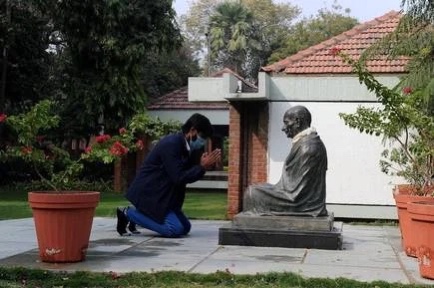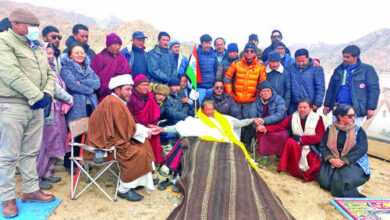Rules and Discipline of Gandhi’s Ashrams
Siby K. Joseph
In the 1990s when I was undergoing a long term training programme at the Sevagram Ashram one of my classmates shared her daily diary which we maintained as a part of the course.
She left the course because she found it difficult to maintain the rigorous discipline of the Ashram. But she rushed back to the Ashram soon and she was readmitted to the course. It was after her return she showed the first page of her diary.
The first sentence reads as follows, “ Sevagram is a prison and I am a prisoner.” I asked her then why you came back? She replied “I realised the beauty of this prison only when I returned to my native place.”
A disciplined way of life is a task in itself for a youngster. But once you start practising it you will understand its significance and love to lead such a joyous life. Gandhi too jokingly described the Sabarmati Central Prison as another Ashram. If you consider Ashram as a prison, the rules and disciplines are the walls which provide greater freedom.
Though Gandhi established ashram like communities in South Africa, he never called them as ashrams. But after returning to India with due thought and deliberation he arrived at the idea of the Ashram with the object of qualifying its members for the service of the country not inconsistent with universal welfare.
From the school of experience in ashram living he realized that the observances of vows were essential for the fulfillment of the very object of the Ashram and systematized the eleven vows for the inmates of his Satyagraha Ashram.
He finalized it after circulating the draft one after another. Each improvement in the draft was the result of mature reflection and demands of the particular situation which he confronted. The vows of the Sabarmati Satyagraha Ashram were Truth, Non-violence or Love, Chastity (Brahmacharya), Control of the Palate, Non-stealing, Non-possession, Physical Labour, Swadeshi, Fearlessness, Removal of Untouchability and Tolerance.
The vows were intended to reactivate and refine the instruments of human cognition which were blurred by one’s own involvement in the phenomenal world. Thus the vows sharpen the abilities of human instruments of cognition which equip an individual to perceive truth in its entirety.
Through the vows Gandhi could create an army of satyagrahies who could face the toughest challenge even by risking their life. The classic example was Salt Satyagraha which literally shook the foundation of British rule in India.
Webb Miller ,Special Correspondent for India, The New York World-Telegram, from Dharasana Camp, Surat District of Bombay Presidency reported to the world the brutality of the British Empire.
He wrote on May 22, 1930,“ In eighteen years of reporting in twenty-two countries, during which I have witnessed innumerable civil disturbances, riots, street fights and rebellions, I have never witnessed such harrowing scenes as at Dharasana. The Western mind can grasp violence returned by violence, can understand a fight, but is, I found, perplexed and baffled by the sight of men advancing coldly and deliberately and submitting to beating without attempting defense. Sometimes the scenes were so painful that I had to turn away momentarily. One surprising feature was the discipline of the volunteers. It seemed they were thoroughly imbued with Gandhi’s nonviolence creed, and the leaders constantly stood in front of the ranks imploring them to remember that Gandhi’s soul was with them.”
This discipline of Satyagrahis could be largely attributed to rules and observances Gandhi placed before the Satyagrahis. He also used the vows as means for uplifting the moral standards of general masses. It is an effective instrument of individual and social transformation even today taking into consideration the moral and ethical degradation which we are facing.
In order to facilitate fulfillment of these observances, a number of activities were interwoven into the day to day life of the Ashram.
1. Congregational worship or prayer “as an aid to self- purification and dedication of one’s all to God.”;
2.Sanitary Service: New entrants were generally given this responsibility and when one qualified this other duties were given.
3. Sacrificial Spinning: It was a central activity of the Ashram, which was compulsory for all members.
4. Agriculture
5.Dairy and
6.Tannery.
In addition, the ashram focused on National Education for spiritual, intellectual and physical development of pupils along with the objective of creating an atmosphere of industry. Instead of just focusing on letters, character building was attended to in the smallest detail. The daily routine of the Ashram was designed in such a manner giving space for all activities.
The rules he penned down for the inmates of Sevagram Ashram towards the end of his life appeared in Harijan, on October 31, 1948. It is considered as Gandhi’s last will and testament on Ashram life. Only those who believe in the necessity of keeping the eleven observances could become a life member of the Ashram by taking a pledge.
The rules he framed were essential for a well-regulated Ashram. He wrote “All members – whether permanent or otherwise – will turn every minute of their time to good account. They will take part in every corporate activity of the Ashram. When free from Ashram work they will spin or carry out some other process connected with cotton. They will prosecute their private studies from 8 to 9 p.m., or during daytime, when they have no Ashram work to do and have spun for at least one hour.”
The rules were not mechanical and arbitrary that is why he said “They may not spin when they are ill or otherwise unable to spin owing to circumstances beyond their control.
He emphasized on the importance of the peaceful atmosphere of the ashram conducive for the practice of truth and nonviolence. “No one should talk idly or in a loud voice. The Ashram must bear the impress of perfect peace as well as of truth”.
He wanted to develop among inmates affectionate, courteous and compassionate behavior to everyone who comes to the Ashram. “Our relations with one another must be characterised by affection and restraint and with guests and visitors by courtesy.
Whether a visitor is dressed in rags or in gorgeous robes, we should treat him with uniform respect. We must not make any distinction between the rich and the poor, the noble and the simple. This does not mean that we may expect a delicately nurtured guest to live as simply as ourselves. That is to say, in waiting upon guests, we must always take into consideration their habitual mode of life. This is true courtesy.”
He reminded them that their every word and act should be well thought out. He reflected on food, water, sanitation, waste disposal and even brushing of teeth.
It shows his holistic approach to look upon life in its entirety. No doubt a fresh look at these rules and observances and its application would help in cultural and spiritual rejuvenation of current materialistic society marked by forces of injustice, corruption, violence and unethical practices.
About the Author
Dr. Siby K. Joseph is Director, Sri Jamnalal Bajaj Memorial Library and Research Centre, Sevagram Ashram Pratishthan, Wardha-442102, Maharashtra.
Email:directorjbmlrc@gmail.com





